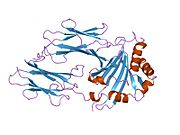HLA-DMA
HLA class II histocompatibility antigen, DM alpha chain is a protein that in humans is encoded by the HLA-DMA gene.[5][6]
HLA-DMA belongs to the HLA class II alpha chain paralogues. This class II molecule is a heterodimer consisting of an alpha (DMA) and a beta chain (DMB), both anchored in the membrane. It is located in intracellular vesicles. DM plays a central role in the peptide loading of MHC class II molecules by helping to release the CLIP molecule from the peptide binding site. Class II molecules are expressed in antigen presenting cells (APC: B lymphocytes, dendritic cells, macrophages). The alpha chain is approximately 33-35 kDa and its gene contains 5 exons. Exon one encodes the leader peptide, exons 2 and 3 encode the two extracellular domains, exon 4 encodes the transmembrane domain and the cytoplasmic tail.[6]
References
- ^ a b c ENSG00000243719, ENSG00000239463, ENSG00000204257, ENSG00000242361, ENSG00000241394, ENSG00000243189, ENSG00000242685 GRCh38: Ensembl release 89: ENSG00000243215, ENSG00000243719, ENSG00000239463, ENSG00000204257, ENSG00000242361, ENSG00000241394, ENSG00000243189, ENSG00000242685 – Ensembl, May 2017
- ^ a b c GRCm38: Ensembl release 89: ENSMUSG00000037649 – Ensembl, May 2017
- ^ "Human PubMed Reference:". National Center for Biotechnology Information, U.S. National Library of Medicine.
- ^ "Mouse PubMed Reference:". National Center for Biotechnology Information, U.S. National Library of Medicine.
- ^ Kelly A, Powis SH, Glynne R, Radley E, Beck S, Trowsdale J (Nov 1991). "Second proteasome-related gene in the human MHC class II region". Nature. 353 (6345): 667–8. doi:10.1038/353667a0. PMID 1922385.
- ^ a b "Entrez Gene: HLA-DMA major histocompatibility complex, class II, DM alpha".
Further reading
- Vogt AB, Kropshofer H (1999). "HLA-DM - an endosomal and lysosomal chaperone for the immune system". Trends Biochem. Sci. 24 (4): 150–4. doi:10.1016/S0968-0004(99)01364-X. PMID 10322421.
- Kropshofer H, Hämmerling GJ, Vogt AB (2000). "The impact of the non-classical MHC proteins HLA-DM and HLA-DO on loading of MHC class II molecules". Immunol. Rev. 172: 267–78. doi:10.1111/j.1600-065X.1999.tb01371.x. PMID 10631952.
- Piatier-Tonneau D, Gastinel LN, Amblard F, et al. (1991). "Interaction of CD4 with HLA class II antigens and HIV gp120". Immunogenetics. 34 (2): 121–8. doi:10.1007/BF00211424. PMID 1869305.
- Kelly AP, Monaco JJ, Cho SG, Trowsdale J (1991). "A new human HLA class II-related locus, DM". Nature. 353 (6344): 571–3. doi:10.1038/353571a0. PMID 1922365.
- Rosenstein Y, Burakoff SJ, Herrmann SH (1990). "HIV-gp120 can block CD4-class II MHC-mediated adhesion". J. Immunol. 144 (2): 526–31. PMID 1967269.
- Bowman MR, MacFerrin KD, Schreiber SL, Burakoff SJ (1991). "Identification and structural analysis of residues in the V1 region of CD4 involved in interaction with human immunodeficiency virus envelope glycoprotein gp120 and class II major histocompatibility complex molecules". Proc. Natl. Acad. Sci. U.S.A. 87 (22): 9052–6. doi:10.1073/pnas.87.22.9052. PMC 55099. PMID 1978941.
- Clayton LK, Sieh M, Pious DA, Reinherz EL (1989). "Identification of human CD4 residues affecting class II MHC versus HIV-1 gp120 binding". Nature. 339 (6225): 548–51. doi:10.1038/339548a0. PMID 2543930.
- Diamond DC, Sleckman BP, Gregory T, et al. (1988). "Inhibition of CD4+ T cell function by the HIV envelope protein, gp120". J. Immunol. 141 (11): 3715–7. PMID 2846691.
- Andrieu JM, Even P, Venet A (1986). "AIDS and related syndromes as a viral-induced autoimmune disease of the immune system: an anti-MHC II disorder. Therapeutic implications". AIDS Research. 2 (3): 163–74. doi:10.1089/aid.1.1986.2.163. PMID 3489470.
- Houlgatte R, Scarmato P, el Marhomy S, et al. (1994). "HLA class II antigens and the HIV envelope glycoprotein gp120 bind to the same face of CD4". J. Immunol. 152 (9): 4475–88. PMID 7512597.
- Chirmule N, McCloskey TW, Hu R, et al. (1995). "HIV gp120 inhibits T cell activation by interfering with expression of costimulatory molecules CD40 ligand and CD80 (B71)". J. Immunol. 155 (2): 917–24. PMID 7541827.
- Rowell JF, Stanhope PE, Siliciano RF (1995). "Endocytosis of endogenously synthesized HIV-1 envelope protein. Mechanism and role in processing for association with class II MHC". J. Immunol. 155 (1): 473–88. PMID 7602119.
- Carrington M, Harding A (1994). "Sequence analysis of two novel HLA-DMA alleles". Immunogenetics. 40 (2): 165. doi:10.1007/BF00188184. PMID 8026867.
- Radley E, Alderton RP, Kelly A, et al. (1994). "Genomic organization of HLA-DMA and HLA-DMB. Comparison of the gene organization of all six class II families in the human major histocompatibility complex". J. Biol. Chem. 269 (29): 18834–8. PMID 8034636.
- Chen YH, Böck G, Vornhagen R, et al. (1994). "HIV-1 gp41 binding proteins and antibodies to gp41 could inhibit enhancement of human Raji cell MHC class I and II expression by gp41". Mol. Immunol. 31 (13): 977–82. doi:10.1016/0161-5890(94)90092-2. PMID 8084338.
- Fling SP, Arp B, Pious D (1994). "HLA-DMA and -DMB genes are both required for MHC class II/peptide complex formation in antigen-presenting cells". Nature. 368 (6471): 554–8. doi:10.1038/368554a0. PMID 8139690.
- Chirmule N, Wang XP, Hu R, et al. (1994). "Envelope glycoproteins of HIV-1 interfere with T-cell-dependent B cell differentiation: role of CD4-MHC class II interaction in the effector phase of T cell help". Cell. Immunol. 155 (1): 169–82. doi:10.1006/cimm.1994.1110. PMID 8168144.
- Sanderson F, Powis SH, Kelly AP, Trowsdale J (1993). "Limited polymorphism in HLA-DM does not involve the peptide binding groove". Immunogenetics. 39 (1): 56–8. doi:10.1007/bf00171797. PMID 8225438.
- Callahan KM, Rowell JF, Soloski MJ, et al. (1993). "HIV-1 envelope protein is expressed on the surface of infected cells before its processing and presentation to class II-restricted T lymphocytes". J. Immunol. 151 (6): 2928–42. PMID 8376762.








